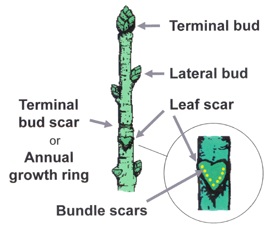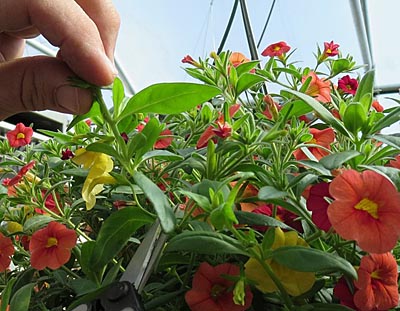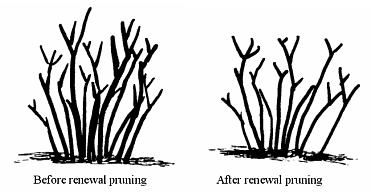Pruning: Addition By Subtraction
By Gil Medeiros, former Fairfax Master Gardener
Something amazing happens when we clip the growing bud at the tip of a branch. This simple act initiates chemical processes within the plant that cause other buds further down the branch to grow into lateral branches. Some of these buds — called lateral or axillary buds — are located where leaves attach to branches. Others, called latent buds, are hiding under the bark of woody shrubs and trees. The science of pruning is based largely on this single phenomenon of plant physiology.

Terminal bud exerts apical dominance on lateral buds
The phenomenon is called apical dominance. Apical refers to the apex or highest point on the branch. The bud at the end of the branch is known as the terminal bud. It exerts apical dominance; in other words, this bud controls growth of other buds lower down the branch. When it is healthy and intact, the terminal bud controls that growth by releasing chemical growth-inhibitors called hormones. These chemicals flow by gravity in plant sap to adjacent buds. Removing the terminal bud disrupts the apical dominance effect on that branch, allowing other buds to grow until another bud takes its place.
Apical dominance allows a plant to concentrate its growth resources on the main shoot growing from the bud at the top of the tree or at the end of a branch. This key process helps the plant grow tall to compete with other plants for sunlight.
So what?
There are three important takeaways for the home gardener:
- To produce a denser, bushier plant, we remove terminal buds by pruning. This stimulates new growth on the branches and stems where those buds were removed. This is addition of new growth by subtraction of the terminal buds.
- To thin a plant that is too dense, we are very careful not to remove terminal buds but rather whole branches where they attach to other branches or trunks. Removing terminal buds would cause the plant growth to become more dense, not less.
- To reduce the height of a plant, we are again very careful not to remove terminal buds but rather whole branches where they attach to shorter whole branches.
Practical applications
Let’s look at several pruning practices and see how removal of terminal buds and manipulation of apical dominance comes into play.

Pinching back a hanging basket
Pinching back
Yes, when we pinch back zinnias, petunias and salvias, we are ending apical dominance in the pinched-back stems. This produces a bushier plant that is not as tall, but will contain many more flowers.
Shearing hedges
When we shear plants with a hedge trimmer, we remove almost every terminal bud on the plant. Not surprisingly, this produces bushy growth in the interior of the plant. Sometimes, to promote light penetration and air circulation for the plant’s health, we must go back and thin out some of the bushy growth.

Effects of renewal pruning
Renewal pruning
This is a three-year process to remove old canes or branches in a shrub that is either overgrown or losing vigor. We remove the old growth one third at a time over the three years. By removing canes and the buds that produce growth inhibitors, we are stimulating new growth from latent buds, called adventitious buds, at the base of the plant. Not all plants can tolerate renewal pruning.
Rejuvenation pruning
This is similar to renewal pruning but more drastic. We remove all of the old canes and branches at once, leaving behind stumps that are under 12 inches high. Later, we thin the new growth to make sure it is not too dense. Again, we are removing buds that produce growth inhibitors, thus allowing latent buds near the base of the plant to grow. Not all plants can tolerate rejuvenation pruning.
Corrective shaping
Let’s say, for example, that one side of a shrub has grown out of proportion to the other. It has a side of strong growth and a side of weak growth. We want the shrub to be uniform and symmetrical. We correct the lopsidedness by pruning the weak side hard to stimulate growth there by removing apical dominance.
Pollarding and coppicing
These are ancient pruning practices that are intended to control the height of certain tree species such as willow. Pollarding reduces the tree annually to small stumps. Coppicing is even more drastic; it reduces the tree to its base. Through the removal of apical dominance, the tree grows thick new foliage. Unknowingly, many landscapers use modified versions of pollarding to control the height of crape myrtles to the detriment of tree health.
So remember: subtraction of one plant part through pruning can result in addition of others, and this often makes the plant more productive and more appealing.
References
• Physiology of Pruning Fruit Trees, VCE Publication 422-025
• Pruning and Training, Christopher Brickell and David Joyce, American Horticultural Society, 2011
• Apical Dominance and Apical Control in Multiple Flushing of Temperate Woody Species, Morris G.
Cline and Constance A. Harrington, National Research Council, Canada
• Winter Pruning for Best Results, Dr. Ron Perry, Michigan State University
… updated 2023